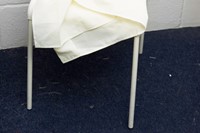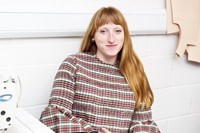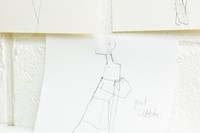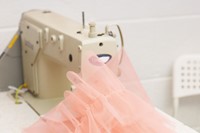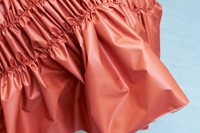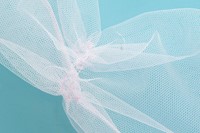Molly Goddard’s London studio space sits just underneath the Westway, in an old school that has recently been transformed into a series of workrooms. On the day that I arrive to rifle through her A/W16 collection, there is a primary school pottery class going on next door and someone, somewhere, is playing guitar quite loudly. “I can’t believe there are kids just running around,” she says, embarrassed. “Plus, everyone else seems to have redecorated their space and we haven’t. But as soon as we got this, we just needed to move right in and get going on the collection.” Thus, her slightly bizarre classroom-come-HQ has all the décor of, well, a primary school, complete with those synthetic blue carpets that you never see outside of one – but somehow, it all makes sense with her the subversion of childhood that marks her aesthetic.
A Family Affair
Goddard's arrival in this space is a new evolution: only a few months ago, she was creating her collections in her mum’s spare room – a space roughly the size of one of the landings we descend down before reaching a room filled with young girls and whirring sewing machines. She is nothing if not resourceful: as we speak, she is still creating her collection, her mother and father are constructing her new showspace at the Tate Britain, her boyfriend is doing all the accounts and her sister Alice is looking after casting and styling. She and her studio still handmake all of her pieces – even the labour-intensive smocking is still done in this little space. Goddard's first show (A/W14, a season before she appeared on the official schedule) employed her friends to stage a tea-party while dressed in her creations – it was brilliantly intimate and a bit weird and set the tone for subsequent seasons, but its design was borne of necessity rather than careful planning: essentially, she couldn’t afford to cast models and the whole thing only cost a few hundred pounds to put on.
"I didn’t realize that fashion was such a money-making machine; that you’d be selling a dress the same way you sell a sandwich" – Molly Goddard
The morning after, she received her first order from IT, Hong Kong’s renowned retailer of the avant-garde, having met them for breakfast with only a couple of hours sleep – then, Dover Street Market was soon to follow. “It’s silly, I didn’t really know what sales meant,” she laughs. “I mean, I know it sounds dumb, but I didn’t even realise everyone went to Paris and did their sales there – nobody tells you that stuff. I didn’t realize that fashion was such a money-making machine; that you’d be selling a dress the same way you sell a sandwich.”
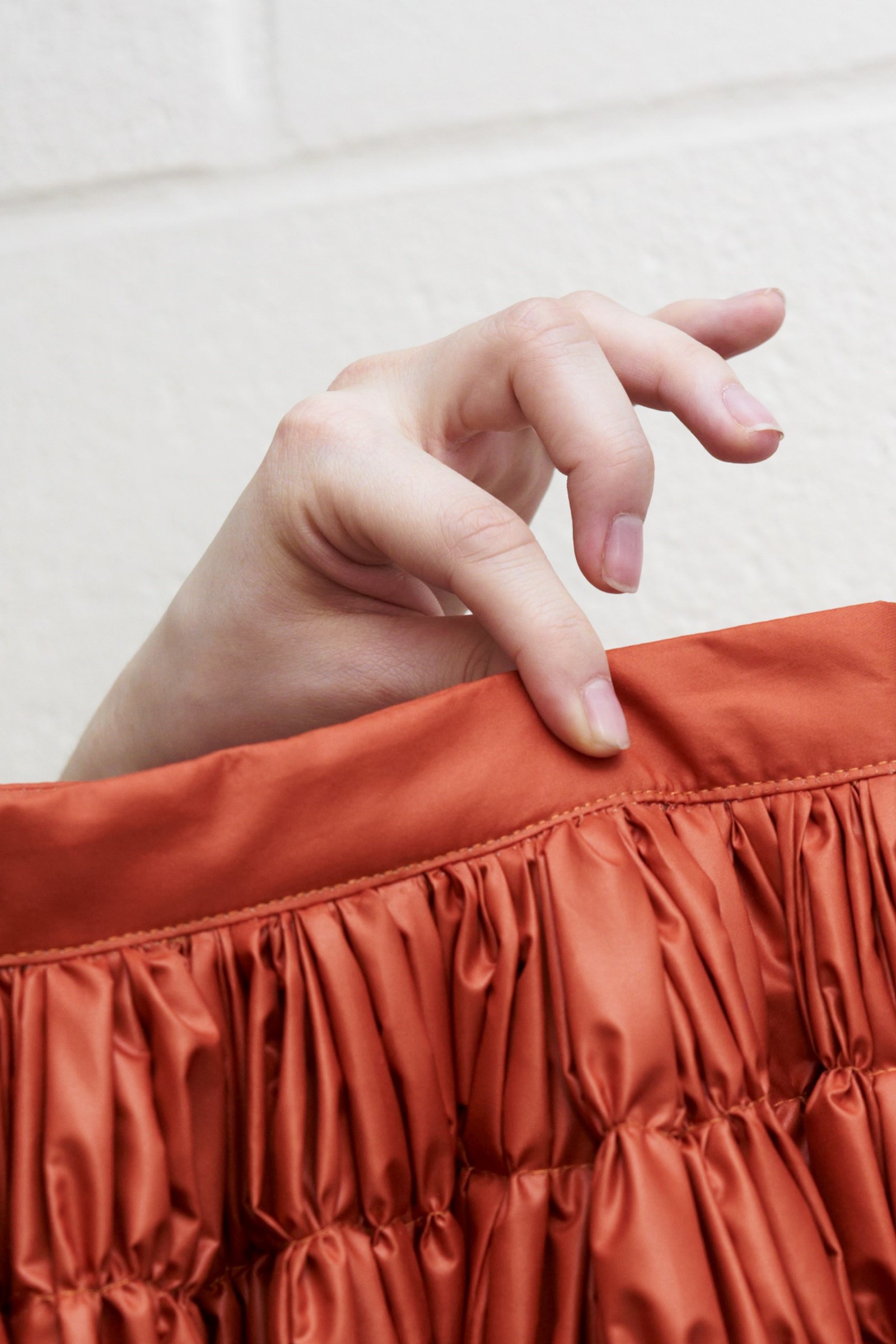
Ham Sandwich Subversion
Funnily enough, last season seemed to riff on this idea – Goddard’s S/S16 presentation at the ICA was set up like a factory, with depressed-looking, stringy-haired girls dressed in tulle and tartan making ham salad sandwiches. It took the collection away from becoming the Disneyland fantasy that it could easily have been, and into the domain of something slightly sinister: it all looked a bit like an abattoir. Such subversion is key to Goddard’s aesthetic – while her creations are often the stuff of little-girl dreams, there is something else to them that makes them so fabulous, something unnerving and perfectly wrong. The pieces are always a little bit big (“I just like ill-fitting things”) or made of a weird fabric (for A/W16, poly-taffeta or a plasticky anorak material that is slightly suffering under the sewing machine needle), maybe in a slightly gross colour. It steers her princess dresses away from the saccharine (“that would repulse me,” she says) and into the distinctly grown up – something that A/W16 has achieved with impressive grace. It's less Harajuku Girl and more Lynn Yaeger (she calls Molly her "spiritual god-daughter").
"I’ve never known anyone to understand what all women want to wear, or how women want to feel" – Molly Goddard
This season, Goddard says that she got obsessed with watching old couture shows on YouTube: the likes of Dior and Galliano “and how they were just so big and grand and the clothes were mental.” The opulence of it all – as well as the tulle and taffeta, which have become her staples – inspired the idea of an orange skirt, which she then formed the rest of the pieces around. The orange skirt has since been cut from the collection, but the essence of grandeur remains – albeit, a grandeur that is more wearable than the couture it takes inspiration from. Charmingly though, that doesn’t seem to be at the fore of her design process – as she gripes, “there are all those terrible sayings that you hear, like ‘who’s your woman?’ I’ve never known anyone to understand what all women want to wear, or how women want to feel. It’s something you hear a lot about male designers, that they really understand. I don’t even think I really understand what a woman wants to wear. I don’t think anyone does.”

Anti-practicality and Sumptuous Desirability
Despite this, Goddard has designed this new collection with more practicality in mind: the reams and reams of silk that can make the pieces slightly extortionate have been cut, bar for a few showpieces. “Yesterday, we even did a proper price range plan,” she says. “But it’s a bit sad to think about, because I don’t particularly want to make everything to be something you can afford. It’s like the couture shows; I don’t think you should just look at fashion and be like, ‘I want to get that’. Maybe you should think it’s exciting and beautiful, and leave it at that; maybe go home and try and make it yourself. Maybe the way to do it is just to make a separate, wearable collection and then do your shows filled with pieces nobody can ever buy.”
"I don’t think you should just look at fashion and be like, ‘I want to get that’" – Molly Goddard
While this might initially sound alienating for those of us not au fait with a needle and thread, it’s the same principle that has guided Comme des Garçons over the past six seasons to resounding success – Rei Kawakubo has recently eschewed conventional runways in favour of a kind of magical, moving exhibition from which the rest of the collection (only seen at the showroom) takes inspiration; both are available to purchase, but one clearly produced in larger quantities. In fact, Kawakubo has been an advocate of Goddard’s since she started out, inviting her into the family of designers housed at DSM – and Molly Goddard will have a permanent home in their new Haymarket store. So, what does the famously cryptic designer have to say about it all? “She said that she liked the tartan dresses and that I should make more," grins Goddard. "But I haven't.... maybe I'll do some for Haymarket." And that's what makes Goddard just so good: a complete and utter rejection of all the things you'd assume a young designer ought be focused on, from Kawakubo's instruction to profit margins, a resolute refusal to make a pair of trousers and just to stick to her guns (although this collection features a coat, very practical). That, and her fantastical clothes, of course.
Retouching James Midwinter

